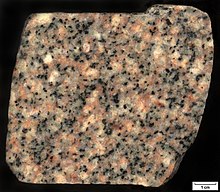Quartz monzonite
| Igneous rock | |
 Quartz monzonite bedrock from a USGS drill core at western Cape Cod, Massachusetts |

Quartz monzonite is an intrusive, felsic, igneous rock that has an approximately equal proportion of orthoclase and plagioclase feldspars. It is typically a light colored phaneritic (coarse-grained) to porphyritic granitic rock. The plagioclase is typically intermediate to sodic in composition, andesine to oligoclase. Quartz is present in significant amounts. Biotite and/or hornblende constitute the dark minerals. Because of its coloring, it is often confused with granite, but whereas granite contains more than 20% quartz, quartz monzonite is only 5–20% quartz. Rock with less than five percent quartz is classified as monzonite. A rock with more alkali feldspar is a syenite whereas one with more plagioclase is a quartz diorite.[1] The fine grained volcanic rock equivalent of quartz monzonite is quartz latite.[1]
The term adamellite was originally applied by A. Cathrein in 1890 to orthoclase-bearing tonalite (likely a granodiorite) at Monte Adamello, Italy, in 1890, but later came to refer to quartz monzonite. The term is now deprecated.[2]
Quartz monzonite porphyry is often associated with copper mineralization in the porphyry copper ore deposits.[3]
Geographic distribution
[edit]The examples and perspective in this section deal primarily with United States and do not represent a worldwide view of the subject. (November 2019) |
United States
[edit]In the White Mountains and western highlands of New Hampshire, the Kinsman Quartz Monzonite is an extensive formation that underlies Kinsman Mountain, parts of Franconia Notch, Mount Cardigan, and Mount Sunapee.[4]
Stone Mountain in Georgia is a large quartz monzonite monadnock.[citation needed]
Quartz monzonite extracted from a quarry in Little Cottonwood Canyon was used to build several buildings in Salt Lake City, Utah, including the Church of Jesus Christ of Latter-day Saints' Salt Lake Temple, Church Administration Building, and Conference Center, as well as the Utah State Capitol.[citation needed]
The large boulders of Joshua Tree National Park in southern California are quartz monzonite.[citation needed]
A large pluton in the Atlanta lobe of the Idaho Batholith, near McCall, Idaho, is made of quartz monzonite.[5]
The Guilford Quartz Monzonite and Woodstock Quartz Monzonite, probably comagmatic, are located in central Maryland.[citation needed]
Australia
[edit]In Queensland, Castle Hill, Mount Stuart and Mount Louisa around Townsville represent a large quartz monzonite province.[citation needed]
References
[edit]- ^ a b Classification of Igneous Rocks Archived September 30, 2011, at the Wayback Machine
- ^ Streckeisen, A. (1 March 1976). "To each plutonic rock its proper name". Earth-Science Reviews. 12 (1): 1–33. doi:10.1016/0012-8252(76)90052-0.
- ^ Titley, Spencer R. and Carol L. Hicks, Geology of the Porphyry Copper Deposits, University of Arizona Press, 1966, p. 35
- ^ Billings, M.P. (1956). "The Geology of New Hampshire: Part II – Bedrock Geology". ngmdb.usgs.gov. New Hampshire State Planning and Development Commission. Retrieved September 17, 2020.
- ^ Idaho Batholith
External links
[edit] Media related to Quartz monzonite at Wikimedia Commons
Media related to Quartz monzonite at Wikimedia Commons
